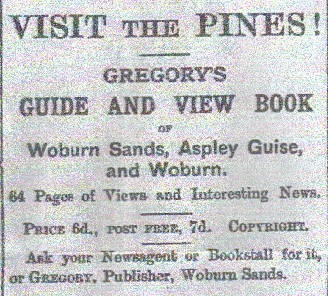
“Gregory’s Guide and View Book of Woburn Sands, Aspley Guise and Woburn” dates from August 1904, and it was advertised in the Luton Times that month.
Herbert Gregory was the local stationer, and also printed many of the local postcards. The book starts and ends with local adverts, which I have spread out throughout the text, with the other photos that were included. (Although many of the adverts seem to be for Gregory’s own businesses!)
Many of the photos are well-known local postcards. A list of 31 postcards produced by Gregory was printed in the local newspaper, “The Woburn Sands Echo and District News” which he also produced, in 1906.
In July 1952, exact copies of this book were produced and sold at an exhibition about Woburn Sands history, which was held at a fete in the Vicarage gardens. There is no indication in these reprints that they are copies, so many people, who have obtained them since, believe they are much older than they actually are.
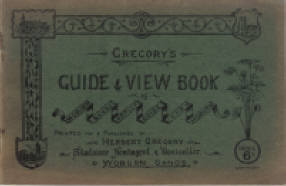
“Nature has scattered around us, on every side, and for every sense, an inexhaustible profusion of beauty and sweetness if we will but perceive it. The pleasures we derive from musical sounds, and the forms of trees, are surely not given us in vain; and if we are constantly alive to these, we can never be in want of subjects of agreeable contemplation, and must be habitually cheerful.” – Basil Hall.
Woburn Sands
Woburn Sands has long enjoyed a high reputation as a health and pleasure resort, and in these strenuous times, when life is lived at high pressure, and when the worries and anxieties of business call for frequent relaxation, it may justly claim attention as an ideal spot where the overworked business man or woman may be sure to find the blessings of renewed health and vigour, the air of the place possessing that peculiar life-giving quality which is so necessary to the building-up of a healthy body. The village is picturesquely situated on the old turnpike road from London to Northampton and the North, and in the “good old times” so much spoken of, enjoyed a fair measure of prosperity by reason of its connection with the old stage-coach industry, the Swan Hotel being the hostel at which the horses were changed. It consists of one long and wide street, from which various smaller streets branch off, the whole being backed by the magnificent wooded lands of the Duke of Bedford, which are the pride of the inhabitants, and the favourite haunt of the many visitors who patronise the locality. The best view of the village is to be obtained from the neighbourhood of the station, and the scene presented to the gaze of visitors, when first alighting from the train, is one of great beauty, and it would be difficult to imagine, and almost impossible to find, a more lovely prospect. The trees, arranged in crescent form, rise tier above tier, and in the Spring –
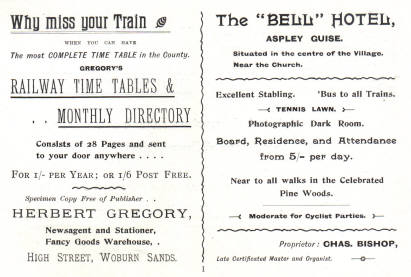
…that soft season when descending showers
Call forth the greens, and wake the rising flowers,
When opening buds salute the welcome day,
And earth relenting feels the genial ray,and when the hitherto bare and brown, but beautiful, trees, are putting forth their tender shoots, heralds of a fuller beauty, the scene is one of indescribable loveliness. The Summer, Autumn, and Winter seasons also endow the scene with a beauty peculiarly their own; indeed, it would be difficult to find a time of the year when beauty was not visible, for, as Dickens says – “Nature gives to every time and season some beauties of its own; and from morning to night, as from the cradle to the grave, is but a succession of changes so gentle and easy that we can scarcely mark their progress.” Leaving for the time a consideration of the natural beauties of the place, we will take a glance at the village itself, which is distant some 50 miles (by rail) from London, 12 miles from Bedford, 36 miles from Oxford, and 42 miles from Cambridge. It is on the Bedford and Cambridge branch of the London and North-Western Railway, and within five miles of that Company’s important junction of Bletchley, so that it may be said to be easily accessible from all parts of the Kingdom.
Apart from its connection with the old coaching industry, previously mentioned, and the existence, up to within a few years ago, of a very ancient Meeting House of the Society of Friends (which is referred to in more detail later), Woburn Sands has historically very little of which to boast, being, like most health resorts, of modern growth. But it reflects, to a certain extent, the glory of its near neighbour Woburn, of which it is very probable it at one time formed a part, although it is now in the awkward position of being in three parishes – Wavendon, Aspley Heath, and Aspley Guise – the many attempts which have been made to get the Local Government Board to grant an independent position to the village having all proved futile. During the early part of last century the village was known as “Hog Sty End,” and even at the present time some of the old inhabitants so designate the old portion of the place.
The etymology of the name is not very clear, but it was, in all probability, an appellation of contempt applied to the place by superior neighbours, by reason, perhaps, of the inhabitants engaging in the occupation of keeping swine. Be that as it may, “A rose by any other name would smell as sweet,” and the opprobrious epithet, if such it was, could not detract from the beauty of the place.
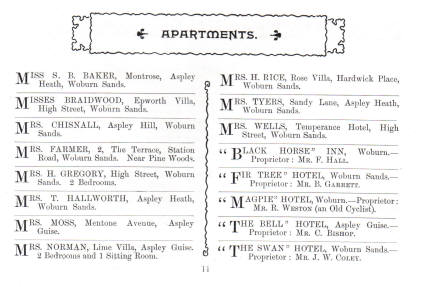
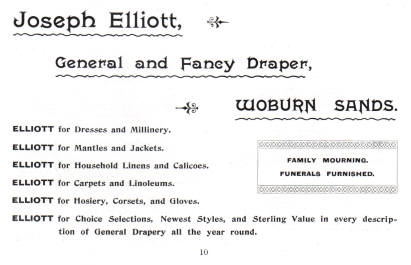
Woburn Sands is a capital centre from which to visit the ancient town of Woburn, and we would recommend visitors to pay a visit, if possible, to Woburn Abbey, which is an 18th century mansion standing on the site formerly occupied by an old Cistercian Abbey, a daughter house of the world-famed Fountains Abbey in Yorkshire. The Park in which the Abbey stands is 12 miles in circumference. A more detailed description of this interesting old town will be found in another part of the guide. A very noticeable feature of Woburn Sands is the many excellent houses which it contains, built in various styles of architecture, and this variety of form adds greatly to the charm of the place. Of course, there are many houses which, in these days of hygiene, are an eye-sore to the sanitary reformer, but they are gradually being replaced by others built more in conformity with the needs of sanitary science. The numerous shops in the High Street are up-to-date in every particular, and as the village is the shopping centre for the numerous small villages in the neighbourhood, a large amount of business is done, the scene on a Saturday night being an extremely animated one.
Local Industries
There are a few industries now carried on in the neighbourhood, the principal being that of brickmaking, which, unfortunately, is not in so flourishing a condition as formerly. A goodly number of hands also find employment in the preparation of a chemical dressing for wheat, designed to prevent the ravages of smut, and the depredations of birds and insects.
The making of straw hats and plait was at one time largely engaged in, but the workrooms had, perforce, to be closed, owing to the centralisation of that particular industry in Luton and other large towns. Lacemaking, an erstwhile flourishing occupation, had also to succumb, to a large extent, to the same influences, although the demand for the hand-made article still provides a somewhat precarious means of livelihood for some of the older inhabitants. For many years the mining of Fuller’s Earth, of which there are extensive deposits on Aspley Heath, was recognised as one of the staple industries of the place, and many hands found employment in the process of procuring and preparing the “earth.” But some three or four years ago two large works were dismantled, largely owing to inability to compete with the Reigate (Surrey) works, where the earth is found much nearer the surface than is the case here, and, consequently, less costly to obtain.
The industry is now only carried on to a very small extent. By reason of the rapid growth of the place, large numbers have at times found employment in the building trade, but this is, of necessity, a somewhat uncertain occupation, the employment being, as a consequence, of a precarious character. But with the fine air and beautiful woods, two invaluable assets, the rise or fall of the industrial barometer may be watched with equanimity.
Places of Worship
The spiritual needs of the inhabitants – and visitors – are well provided for, the number of buildings used for Divine Worship amounting to five, although one (a Calvanistic Baptist Chapel) is now but rarely used.
The PARISH CHURCH (St. Michael’s) occupies a commanding position on Aspley Heath, and is a fine building, admirably adapted for purposes of public worship. Previous to the year 1868, Woburn Sands, with the exception of Aspley Heath, and a small portion which was in the parish of Aspley Guise, belonged to the parish of “Wavendon, and mission services, arranged by the Rector of Wavendon, were held in a small room near the “Swan” Hotel. About that time the Rev. J. Vaux Moore, Rector of Aspley Guise, left the sum of £5,000 to provide an endowment for a new parish of Woburn Sands, on condition that the then Duke of Bedford provided Church and Vicarage, the patronage of the new parish to be in the gift of the Duke of Bedford.
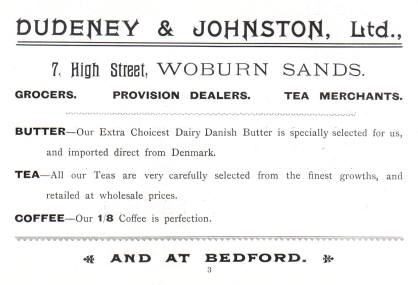
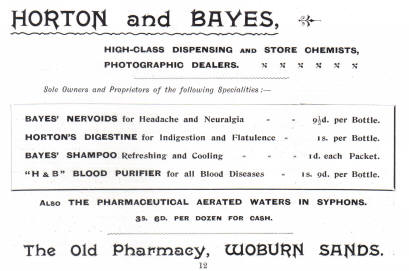
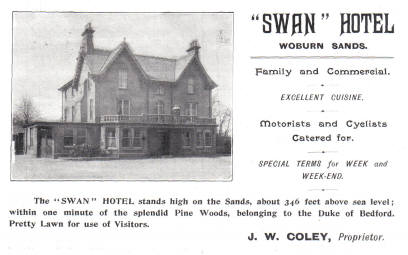
This arrangement was carried out, and the Church was built, the consecration taking place on the 22nd April, 1868, the ceremony being performed by the then Bishop of Ely, Bishop Harold Browne. The ecclesiastical district assigned to the new parish consisted of parts of the parishes of Wavendon and Aspley Guise, and the whole of the parish of Aspley Heath, this constituting a large but compact parish. The first gentleman to occupy the position of Vicar of the new parish of Woburn Sands, was the Rev. Hay M. Erskine, Rector of Aspley Guise, who resigned the living of Aspley Guise for the purpose.
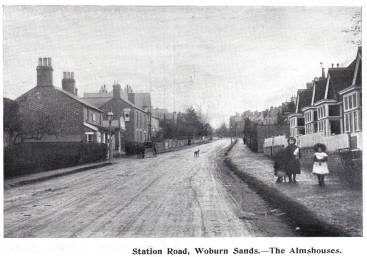
The Rev. James M. Hamilton succeeded Mr. Erskine in 1875. In 1883 the Rev. E. H. Mosse was appointed Vicar, Mr. Hamilton having previously accepted the charge of the parish of Ridgmont. Mr. Mosse was vicar for 16 years, and on his removal to St. Paul’s, Covent Garden, in 1899, he was succeeded by the Rev. C. R. Dickinson, Mr. Dickinson only stayed a year, being then appointed Vicar of Woburn. The Rev. Douglas W. Henry, M.A., of Exeter College, Oxon., the present Vicar, who had for some years worked in the democratic parish of Battersea, was then appointed, and he is assisted by the Rev. John Shelton, as Curate. In 1889 the Church, not proving large enough for the congregation, was enlarged, the enlargement consisting of the lengthening of the Chancel and the addition of the North Transept. The South Transept still remains to be added. There are two stained glass windows in the Church, that in the East having been put in by the Congregation in memory of Mr. Denison, a member of an old local family, who expired suddenly in the Church some 14 years ago. That in the transept was also put in by the Congregation, in memory of the Misses Stuart. The reredos, which is a handsome one, was given by the Misses Pain, in memory of their sister. All the seats in the Church are free and unappropriated, and the services, which are essentially congregational, are as follows:- Sundays – Holy Communion at 8 and 11a.m., with an extra celebration at 7a.m. on the first Sunday of the month; Morning Prayer at 11; Children’s Service at 3; Evening Prayer at 6.30. There are daily services at 9a.m. and 6p.m., except on Wednesday and Friday, when the Morning Service is at 11. On Thursdays and Saints’ days there is a celebration of the Holy Communion at 8 a.m.
THE FRIENDS’ MEETING HOUSE. – This is a handsome, modern built building, but a great deal of interest attaches to it by reason of its standing on the site formerly occupied by a quaint old Meeting House, a portrait of which we give on another page. As the history of the Society of Friends in the neighbourhood extends over so many years, it may not be out of place to give a few particulars relating to the old building, which is held in affectionate remembrance by hundreds of Friends in all parts of the world. There seems to be a remarkable scarcity of documents relating to this ancient building, all the title deeds between 1674 and 1822 being missing. But upon a perusal of the entries of deaths and burials, there would appear to have been upwards of 200 interments previous to the burial of the Poet Wiffen in 1836, which may fairly be presumed to indicate that the adherents of the Society of Friends in the neighbourhood were numerous. The first reference to Quakerism in the parish was in 1659, when Friends who were riding to a Meeting at Wavendon, had their horses confiscated for Sunday travelling.
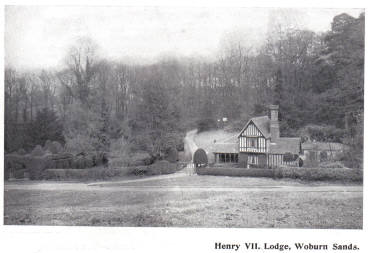
In 1667 Jane Cooke, of Bow Brickhill, was buried at “Hogsty End, Bucks,” this being the name by which the property was designated. There is a subscription list on parchment, dated 1673, with the name of “Hogsty House” on the heading, suggesting that the property was purchased with a pre-existing edifice upon it, but when, in the following year, Richard King, yeoman, of Aspley Guise, sells the property for the sum of £50 to William and E. Cooke, of Bow Brickhill, yeomen; Thomas Harvey, yeoman, Wavendon; Henry Bigg, shoemaker, Wavendon; Francis Coleman, ironmonger, Woburn; Francis Ireland, gardener, George Gosling, shoemaker, Little Brickhill; and William Matthews, yeoman, Aspley Guise, it does not mention any building as being in existence. In 1668 Thomas Harvey had buried his wife in his own ground at “Wandon.” In 1675 the “Hogsty End” Meeting House was erected, at a cost of £135, a small sum in these days, but in those early days it was considered a good figure. It was not until 1822 that the Friends of those days executed a new trust deed, Richard How and Peter Bassett being amongst them. These Friends must have been personally acquainted with people whose memories went back to the days of the Stuarts and the early Friends. Although the very early history of the Friends seems to have been lost, yet for the last 100 years we are more enlightened. The published memoirs of the Brothers Wiffen, who are buried in the graveyard of the Society here, and were members of the Meeting, furnish us with much interesting information. In the old coaching days, Woburn was a busy, bustling place, and in a house next door to the Bedford Arms Hotel, there was born on December 30th, 1792, Jeremiah Holmes Wiffen, poet, and librarian to the then Duke of Bedford. Here also was born Benjamin Barren Wiffen, who became in after life the celebrated Spanish scholar, and was known as such in all the libraries and universities of England and on the Continents of Europe and America.
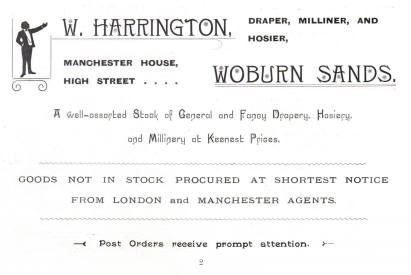
The youngest sister, Priscilla, herself a poetess and writer, married the poet Alaric Watts. Jeremiah died suddenly in 1836, and his burial was a remarkable scene by reason of the immense concourse of people who assembled to witness the obsequies. His brother Benjamin died 31 years later, and both rest in the quiet Quaker graveyard. Another notable Friend was Richard How, a splendid scholar. He collected a remarkable library, containing over 5,000 rare and notable books. After the days of the Wiffens and the Hows, the members and attenders of the Meeting declined so much that the last monthly Meeting was held May 12th, 1865, and eventually it became closed altogether. This was in 1871, when the Meeting found itself reduced to one, and in November of that year this Friend, who used to walk from Ampthill, found himself, from advancing age and weakness, unable to attend. After this period various attempts were made to carry on Christian work in the old building, but with little success.
In 1896 W. C. Collyer held many meetings, covering several months, and in July, 1897, William George Hall, a missioner of the Society of Friends, was invited from Henley-on-Thames to organise and carry on Christian work in the village. The old place speedily became too small, and was used for the last time on May 19th, 1901. The demolition of the old structure was opposed by the Society for the Protection of Old Buildings and many antiquarian Friends, but sentiment could not be allowed to stand in the way of the needs of the congregation, and the present handsome and commodious structure was erected, and opened in December, 1901. The building, which cost £1,733, is entirely free of debt, and will comfortably seat 400 people, the Meeting House and School-room being divided by means of a sliding screen, which can be removed as occasion requires. The ordinary Quaker service is held every Sunday morning at 11, and in the evening at 6.30 an evangelical service is conducted. There are two Adult Schools (Men’s and Women’s) in connection with the work, which meet on Sunday and Wednesday afternoons respectively, while there are also various other organisations carried on.
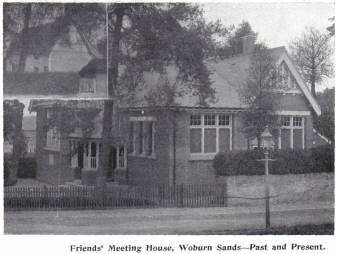
THE WESLEYAN CHAPEL, which occupies a splendid position in the High Street, is a handsome and commodious structure. The inside of the building presents a very pleasing appearance, being lofty and well-proportioned, while the furnishings are of a very substantial character. Behind the Chapel is a large School-room, which was built some 12 years ago, while beneath the School-room are numerous Class-rooms, etc. The Chapel is heated by means of hot air, and the School and Class rooms by steam pipes. Wesleyan Methodism has been established in the village for many years, and its history has been one of which any religious body might well be proud. The local “Church” has been the nursery of many who have occupied eminent positions in the ministry of the Wesleyan Connexion. The ordinary Sunday services are held at 11 a.m. and 6 p.m. The services are often conducted by one or other of the “circuit” ministers, and at other times by local preachers, or a student from one of the Connexion’s theological seminaries. There is a large Sunday School (held at 9.30 a.m. and 2.30 p.m.) connected with the Church, while various works of a social character are also carried on, including a flourishing Temperance Society and a Band of Hope.
THE PRIMITIVE METHODIST CHAPEL is on Aspley Hill, and is a square built building, erected without any pretensions to architectural beauty. It has been for a number of years the head of a “circuit” and the “home” of a community of zealous Christian workers, whose self-sacrificing labours have contributed not a little to the moral welfare of the village and its inhabitants. Like many another small village “church,” the cause has passed through many vicissitudes, but present indications point to a more settled and prosperous future. The Sunday services, which are held at 11a.m. and 6p.m., are often taken by the station minister (who resides at Woburn Sands), and sometimes by one or other of the various local preachers of the circuit. There is a Sunday School in connection with the work, held in the School-room adjoining, in addition to week-day meetings of various kinds.
THE CALVINISTIC BAPTIST CHAPEL is a small but pleasing looking structure, situate in Theydon Avenue. The fact that it is now but rarely used would seem to indicate that, locally, there are few who hold the tenets peculiar to that particular branch of the Christian Church. Attempts have been made by other religious bodies to purchase the building, but, so far, without success.
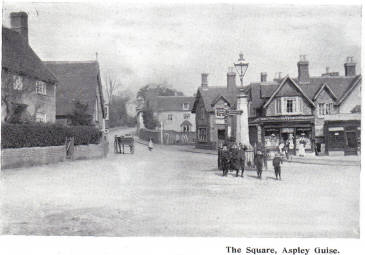
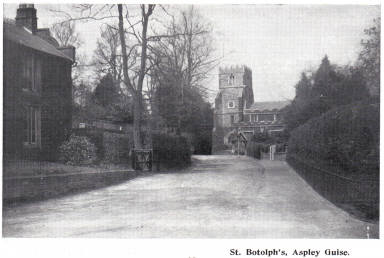
Public Buildings Schools & Co.
Woburn Sands possesses a fine and commodious public hall, commonly known as “The Institute,” situate in the High Street, and erected by Public subscription. The building is a lofty one, and is possessed of excellent acoustic properties. It will seat between 200 and 300 people. The floor is of polished pitch pine, and affords a splendid surface for dancing. There are two ante-rooms and the usual offices attached to the building, and the control is vested in trustees, the secretary being Mr. E. G. Miller, to whom all applications for the hire of the Hall must be made. The building is let at a low cost. Another building available for public meetings is the Club Room adjoining the Fir Tree Hotel, while the various School-rooms belonging to the numerous places of worship are also used for the same purpose.
There is a large CLASSICAL SCHOOL on Aspley Heath, conducted by the Ven. Archdeacon Miller and the Rev. F. F. Hort, where some 30 pupils are educated. The building is a handsome modern structure, and is in close proximity to the woods. There are also private Schools in the village.
THE COUNTY COUNCIL SCHOOLS. -These consist of a fine group of buildings situate at the bottom of Aspley Heath, while another entrance is from the main road. All the rooms are high and well proportioned, and afford ample accommodation for the children of the neighbourhood. The infant school is held in a separate building, which was built some few years ago. The head-master is Mr. F. G. Sharp, and the head of the Infant School is Miss Cheetham.
THE MEN’S SOCIAL CLUB, of which Mr. J. McMurtrie is secretary, is domiciled in a building situate near the top of Russell Street. The roll of members is a lengthy one, and the club possesses every facility for their enjoyment. There are two large billiard tables, and other rooms are set apart for the playing of various games. Visitors are allowed participation in the benefits of the club on payment of a sum of 1d. per day.
There are several CHARITIES belonging to the civil parish of Wavendon, which are highly valued by the poorer parishioners. One of the most noteworthy, as it is one of the most recent, evidences of thought for the welfare of the world’s less fortunate ones, is to be found in the ALMSHOUSES, a view of which we give. They are six in number, and occupy a prominent position in the Station Road. The houses are well built, and consist of a sitting-room, bedroom, and scullery, all on the ground floor, with a fair-sized piece of garden ground attached. In addition to living rent free, the occupants are allowed the weekly sum of 5s. each for their maintenance. The almshouses owe their existence to the generosity of the late Mr. F. W. Down, and his legatees, Mr. and Mrs. W. Needham, have carried out his wishes in regard to them in a very thorough and praiseworthy manner.
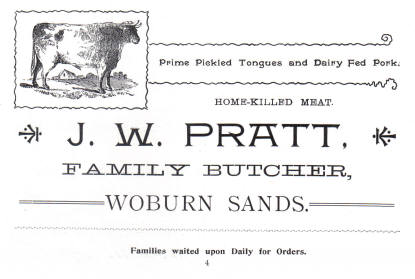
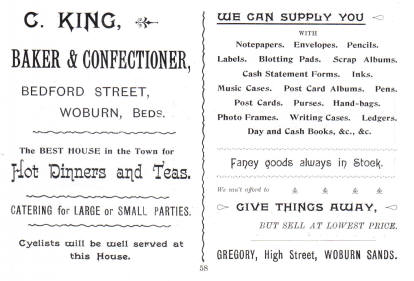
THE SANATORIUM FOR CONSUMPTIVES – This neighbourhood has always been recognised as a suitable place of residence for those suffering from chest and lung complaints, and many well authenticated instances are on record of people having derived material benefit from a stay in the district. The remarkable dryness and purity of the air, and the absorbent nature of the soil and sub-soil, not to mention the plenitude of pine and fir trees, which load the air with their sweet and healthy scents, are important factors in the production of this suitability. It was, undoubtedly, a consideration of these facts which induced the donors of the Sanatorium on Aspley Heath to choose that particular spot on which to erect it. The building is situate on the top of the hill, at an altitude of some 600 feet above sea level, and is surrounded with pines and firs in various stages of growth, which serve to temper the keenness of the winds at so great a height. The Sanatorium owes its existence to the generosity of a philanthropic lady and gentleman, Mrs. and Mr. Bischoffsheim.
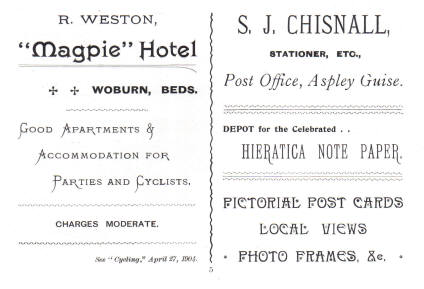
Woods, Walks & Co.
It has been said that Woburn Sands without its woods would be like the play of Hamlet without the Prince of Denmark, and there is some modicum of truth in the parallel, although there are many beautiful nooks in the neighbourhood which entitle it to take rank amongst Nature’s most favoured spots. But the interest of visitors undoubtedly centres round the woods, and full advantage is always taken of the privilege accorded them of wandering at will over nearly the whole of this beautiful domain. Of course, there are some few paths which are kept private, but as these are plainly shown, there is little fear of anyone unwittingly trespassing on forbidden ground. It is impossible to enumerate, or even clearly indicate, the many beautiful walks which may be enjoyed in the woods, but the visitor will soon master the topography of the place, taking care, of course, not to wander too far afield to begin with. Passing up the main street of the village, in the direction of Woburn, a pretty lodge, known as “Henry VII. Lodge,” an illustration of which we give, will be seen on the left, and the visitor will not fail to notice here some curious specimens of topiary work in yew, the remains of what was at one time a “maze.”
The woods may be entered at this point, and by following the broad road bearing to the left, Aspley Guise will be reached. Farther up the road, on the opposite side, is another gate admitting to the woods, the various paths which branch off leading to many beautiful nooks. Still farther up the road, a deep cutting is passed through, the banks being covered with luxurious vegetation, prominent amongst which many beautiful ferns will be noticed. Beyond this, still more gates invite the visitor to enter and enjoy the sylvan beauties and quiet of the wood. About half-way to Woburn, on the right hand side of the road, a very pretty lodge, standing some fifty yards back, and known as “Fuller’s Earth Lodge,” is seen, and should the visitor care to traverse the broad green walk that stretches before him, he will in time reach the quaint old village of Bow Brickhill, from which magnificent views of the surrounding country may be obtained.
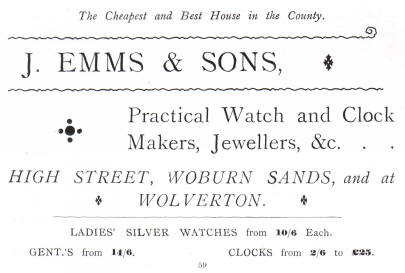
The Church, which stands on the top of the hill, is worth a visit, both by reason of its antiquity, and of the fact that the choir of days gone by was the original of Sir David Wilkie’s famous picture, “The Village Choir.” Of course, there are other directions than those indicated from which the woods may be entered, notably from Aspley Heath, and by way of a footpath leading across fields, the entrance to which is opposite the Friends’ Meeting House; but we have no doubt visitors will soon make themselves acquainted with the various walks. Although cycles and motors are not allowed in the woods, the firm and level surfaces of the roads invite indulgence in these particular forms of recreation, and there are many points of interest in the neighbourhood which will well repay a visit. It were vain to attempt a description of the natural beauties of the woods, as even with the pen of a Charles Kingsley, we are afraid adequate justice could not be done to them. Many choice flowers grow in profusion, among them the chaste Lily of the Valley, while the majestic Foxglove rears its head aloft. The Wild Woodbine is seen clinging to every available support, and the air is redolent with its sweet scent. Ferns and bracken abound, while many a choice floral gem is “born to blush unseen.”
Gigantic trees are to be seen in all directions, and although at times, “Wielded by sturdy hands, the stroke of axe makes the woods ring,” the spaces cleared are soon filled up, and healthy youngsters give promise of equalling, or perhaps rivalling, the forest giants whose erstwhile places they fill. There is abundance of game and other forms of animal life, while occasionally deer may be seen wandering at will over the woodlands, their graceful forms adding greatly to the charm of the scene. At night, when “the sable Goddess from her ebon throne in rayless majesty . . . stretches forth her leaden sceptre o’er a slumbering world,” and when the stars, seen through the interstices of the thick-leaved trees, appear like fireflies dancing in the air, the woods will well repay a visit, as, mingled with the sound of the “soft winds that run along the summits of the trees in music,” will perhaps be heard the dulcet strains of the nightingale sending forth a flood of melody from some unseen place, “in varying strains of Divine music, broken by many pauses, and running through every phase of jubilation, sorrow, and pain.”
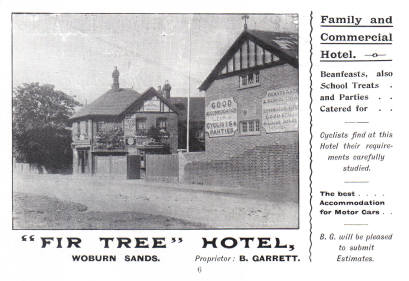
Occasionally, also, will be heard the call of the owl or the night-jar, varied, perhaps, by the barking of a stray fox, or one or other of the numerous sounds that are noticed only at night-time. The foregoing is but a feeble attempt to describe the various enchantments of our glorious woods, but we think they are aptly summed up in the following words of Bryant’s:-
Here are old trees, tall oaks, and gnarled pines,
That stream with grey-green mosses; here the ground
Was never trenched by spade, and flowers spring up
Unsown, and die ungathered. It is sweet
To linger here, among the flitting birds
And leaping squirrels, wandering brooks, and winds
That shake the leaves, and scatter, as they pass,
A fragrance from the cedars, thickly set
With pale-blue berries.
Aspley Guise
The exceedingly pretty village of Aspley Guise is situated in the South-Western portion of the County of Bedfordshire. From the hills around the Village, the views are charming and extensive, that from the walk across the Common perhaps being the fairest of them all. From this spot, on the left, can be seen the pine trees in the Duke of Bedford’s Woodlands, their tops outlined against the sky; while broad before one the land seems to stretch away in miles and miles of squares of field and meadow fringed with trees, and dotted here and there with cottage, Church, or farm. On a clear day the spire of Hanslope Church, ten miles distant as the crow flies, is easily distinguishable.
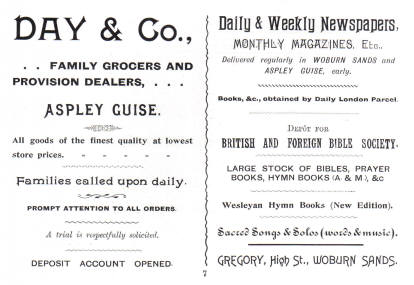
Evergreens flourish on the sandy soil of the Village, and the Holly (Ilex Aquifolium) in particular, so that even in Winter, while many villages, through lack of foliage, look barren and brown and bare, Aspley still wears a mantle of refreshing green, and the hollyberries, like rubies, glisten amongst the prickly leaves.
But Aspley has her charms in all seasons of the year. In the Spring, “when lillies blow,” and the trees are putting forth their leaves, and the Larks rise to greet the morn, or “The Nightingales breathe out their souls in song.” In Summer, when the leaves shimmer in the breeze, and “The Woodbine spices are wafted abroad,” and the hills and lowlands are clothed with emerald grass or corn. In Autumn, when the Woods are gorgeous in gold and crimson and brown, mingling with the unchangeable hue of the pines. And in Winter, as we have said, loveliness still abounds. In the Woods the winds chant their psalms amongst the Pine Trees, while at their feet the mosses are green and beautiful, so that one might imagine that it was here that Ruskin saw those “rounded bosses of furred and beaming green.”
On entering the Woods, carking care seems to fly away. Bryant’s words may here be verified:-
Stranger, if thou hast learned a truth which needs
No school of long experience, that the world
Is full of guilt and misery, and hast seen
Enough of all its sorrows, crimes, and cares,
To tire thee of it, enter this wild wood
And view the haunts of Nature. The calm shade
Shall bring a kindred calm, and the sweet breeze,
That makes the green leaves dance, shall waft a balm
To thy sick heart. Thou wilt find nothing here
Of all that pained thee in the haunts of men,
And made thee loathe thy life.
Yes, Peace seems to brood over the Woods – a holy calm pervades them. And when the breezes blow, one hears “A little noiseless noise among the leaves,” or the wind-psalm. Birds here pour out their glad notes undisturbed. In some parts of the Woodlands one is reminded of Longfellow’s “Evangeline“:-
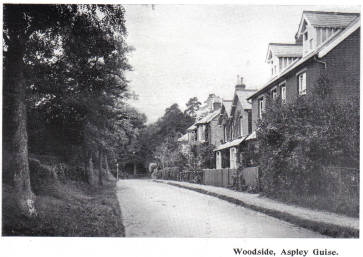
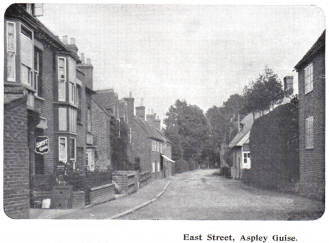
This is the forest primeval. The murmuring pines [and the hemlocks],
Bearded with moss, and in garments green, indistinct in the twilight,
Stand like Druids of eld, with voices sad and prophetic,
Stand like harpers hoar, with beards that rest on their bosoms.
But the writer raises but a feeble voice of the present. Let those of the long past now speak to us. Turning to the “History of Woburn and its Abbey,” by J. D. Parry, M.A., formerly a resident of Aspley, we find the following reference made to the Village:-
“ASPLEY GUISE. – About two miles north of Woburn, is a large and very handsome village, and one of the most esteemed in the county for respectability and pleasantness of situation. In the record of Doomsday Book, Aspley, called in Latin Aspeleia, as a portion of the Barony of Bedford, formed part of the extensive possessions of the Beauchamps.
“Aspley answers for x hides. Acard of Ivry holds it of Hugh (de Beauchamp). The (arable) land is xii carucates. In demesne are 2 carucates, and a third may be made, and xvi villeins have viii carucates, and a ninth can be made. There are iv bordars, and v servants, and i mill of ten shillings. The meadow land is x carucates: wood for 50 hogs. In the whole they are worth viii pounds: when he received it 100 shillings: in the time of King Edward X pounds. Leuena, Countess of Earl Wallef, held this manor, and could retire with (in the possession of) her land, where-ever she pleased.’
“It seems, however, that Earl Wallef and his wife were not entirely dispossessed of their lands on the accession of the Conqueror; as they are recorded in Doomsday Book to have given, during his reign, to the Abbey of St. Edmund (Bury) certain lands in the Hundred of Biggleswade, for alms, there called Chenemondewiche; the situation of which is now unknown.
“Simon de Beauchamp surrendered it by way of a composition to Guy de St. Walery, who had laid claim to his whole barony. Reginald de St. Walery gave it to Hubert de Burgh, Earl of Kent, and Grand Justiciar of England, whose widow Margaret, daughter of the .King of Scots, died seised of it, as her dower, in 1259. After this Aspley became the property and chief seat of the Gyses or Guises, ancestors of the Gloucestershire family of that name. Anselm de Gyse had this manor in marriage with a daughter of Hubert de Burgh above mentioned. John de Gyse was one of the knights of this shire in 1328. In 1540, John Guise, Esq., gave the manor of Aspley to King Henry VIII., in exchange for lands in Gloucestershire. It is probable that the king granted it to Sir Ralph Sadlier, one of his chief favourites, whose descendants are still possessed of it. Edwin Sadlier, of Aspley, was created a baronet in 1661. Sir Edwin Sadlier, his son, the last baronet, died in 1719, bequeathing the manor of Aspley to his kinsman, George Sadlier, Esq., from whom it has descended to the present proprietor, Richard Vernon Sadlier, Esq.” – Lysons.
“Aspley had formerly a market on Fridays, and a fair at St. Botolph’s tide, granted to Anselm de Guise, in 1267. In the year 1223, the advowson of the church was contested between the priories of Newenhain and Dunstable, the former of which obtained the right. The parish contains about a thousand inhabitants, and has several handsome residences. A classical school has been established hers upwards of a century, which has attained some celebrity, and has spacious buildings eligibly situated. The church consists of a nave, north aisle, and chancel, on the south side of which is a window of the fourteenth century: the tower is large, and contains four bells. At the east end of the north aisle, which may possibly have been a chantry chapel, is an altar tomb, with the recumbent effigies of a warrior in chain armour (called also hauberk and acquetoun), a fashion which fell into disuse about the year 1350. [Stothard.] The arms are ‘argent, engrailed, on a bend three lance heads inverted.’
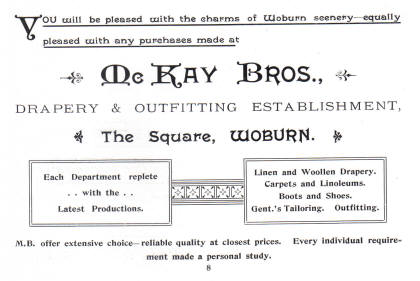
There are also two brasses, one of them with four shields of arms. On the north side of the chancel is a brass tablet, with these Latin verses, from which we collect, that William Stone, M.A., was thirty-five years rector of this parish, and died, aged seventy-two, in the fifteenth of James I. (1618).
ES HIHI MOBS LUCRDM.
Subjacet inclusus Qulielmus Sionus in urna
Cui natale solum Norfolcia, villaque Burnham
Oceatuim juxta ; non ampla stirpe creatus;
Veste Magisterii quern Cantabridgia cinxit:
Sederat hie liyemes decies ter quinque peractas,
Septuaginta duos vitas compleverat annos,
Cum tria Jacobus moderasset lustra Britannos;
Spe certa fldens virtute resurgere Christi,
Et cum coelicolis ajternam ducere vitarn.
There is also a handsome monument to Mr. William Wright, a highly respected master and ‘second founder’ of Aspley school.
“Aspley Wood is one of the most beautiful and romantic in the kingdom, and has inspired Mr. Wiffen, in his poem of ‘Aonian Hours.’ Not the least source of its pleasantness consists in its thickets being, in the beginning of the summer, overspread with a profusion of those most beautiful flowers, the lilies of the valley. The names of admired objects, and their own, are very liberally bestowed on the ‘ glossy rinds’ of many of the most picturesque trees, by aspiring candidates for a distinction similar to the old classical one et in Arcadia ego.
“This Wood is also a favourite resort of the nightingale, and of the glow-worm,
who often exhibits his silver lantern, till he [sic., but should read “her” and “she” – C.J.M.]
. . scents the matin to be nigh,
And ‘gins to pale his ineffectual fire.
We will give one other quotation in praise of Aspley Wood, from “The Brothers Wiffen “:-
“ASPLEY WOOD – Who that has wandered in childhood and youth through the arched recesses and arcadian avenues of Aspley Wood, can ever cease to remember the delight of its beechen groves and fir-clad heights? What pictures of its rich woodland beauty remain indelibly stamped by memory on the mind evermore!
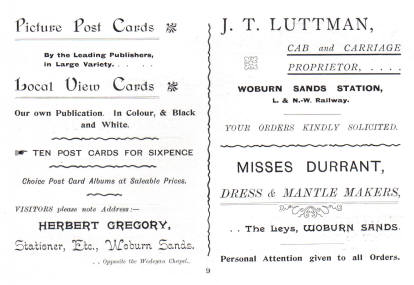
“In Spring, the moss-covered banks, the greensward white with the wood anemone, golden with primroses, and blue with the fairy bells of the hyacinth – whilst hidden in dewy recesses of the leafy underwood, lie whole beds of the fragrant lily of the valley. In Summer, the festoons of sweet wild woodbine flung hither and thither in perfumed luxuriance, the varied carpet of yellow cistus, purple foxglove, blue harebell, white wild strawberry flower and scarlet strawberry fruit, and tracts of bilberry bushes with the blue purple bloom on their juicy berries. In Autumn, the banks of purple heather and ling, and sweeping fronds of bracken fern – the brilliant glow of colour over all – golden, and crimson, and green, over beech tree and oak – scarlet, and yellow, on sycamore, plane tree, and maple – whilst unchanged through all, rises the dark green shadow of the cedars and pine trees, through whose gently waving branches the Autumn wind murmurs soothingly, as it whirls the sere leaves in rustling masses to one’s feet. In mid-winter, on a bright frosty day, how beautifully does the frosted tracery of dark firs gleam out against the cold blue sky, whilst on the ground, around their red branching roots, lies the track of the wild rabbit, or forest squirrel, over the new fallen snow.”
Perhaps we cannot do better in bringing the brief appreciation of this fair Village to a close, than by quoting a portion of a poem by Louisa Bigg, in “Pansies and Asphodel ” :-
Circled round with pasture lies
The enchanted village, Aspley Guise;
Sandy street, and field and park,
Waving elm and fir-tree dark;
Mansion, cottage, dale and hill,
Far from noise of mart or mill,
Lie before us, soft and still,
As if some spell were o’er them cast.
Filled with memories of the past,
Pass we through the silent street,
Till at length we stay our feet
Near the Church, whose walls are dight
With fragrant roses, dazzling white.
The Church we enter – soft and low
Sweet rivulets of music flow;
In the dim light some hand unseen
Is wandering o’er the keys, I ween.
These melodies, mysterious, glad,
Mind me of Sir Galahad,
And the Chapel strange he found
With sombre woods encompassed round.
The windows richly painted, glow
With mellow light; the floor below
Mosaic decks in every part;
The pulpit carved with curious art,
Towers dark aloft; and words divine
Around the graceful arches twine.
Filled with holy, chastened gladness,
We leave the Church. The abode of sadness,
The place of tombs, we fain would see;
Yet, fairy village, can it be
That Grief and Death e’er visit thee?
They come – but even thy graves are bowers,
And Death himself seems wreathed in flowers:
Sweet blossoms in profusion grow
Where’er our wandering footsteps go,
No gloomy shadow resteth here,
The sepulchre is robbed of fear.
Shops, Post Office & Co.
The population of Aspley Guise is about 1,206. There are excellent shops in the Village; with Post, Telegraph, and Money Order Office having three Deliveries and five Despatches on ordinary days, as follows:- Postal Deliveries – 7a.m.;12.20p.m.; 5.10p.m.: Sundays – 7a.m. Postal Despatches. – 10a.m.; 11.40a.m.; 4.20p.m.; 7.50p.m.; 10p.m.: Sundays – 7p.m. The shops close at 8p m., excepting on Wednesdays and Saturdays, when they close at 4p.m. and 10p.m. respectively. Aspley is lighted by gas, incandescent mantles being used for the lamp in The Square, which sheds forth a brilliant light from a tall obelisk given to the Village by the late Charles Hervey Smith, of Aspley House.
Railway Station & Co
A ‘bus meets all trains at Woburn Sands Station (L. & N.-W. Ry.), Railway which is about 11 miles distant from the centre of Aspley Village (The Station, &c. Square). There are usually about 10 trains running up towards Bletchley and London, and 10 trains running down towards Bedford and Cambridge from Woburn Sands daily, excepting Sunday, on which day, in the morning, usually one comes up from Cambridge to Woburn Sands (departing for Bletchley), and another reaches Woburn Sands from Bletchley (departing for Cambridge). In the evening, one train arrives at Woburn Sands from Cambridge, departing for Bletchley. London is about 50 miles distant from Woburn Sands Station; Oxford, 36 miles; Bedford, 12 miles; Cambridge, 42 miles.
Places of Worship
There are three places of Worship in the Village, as follows:- PARISH CHURCH (St. Botolphs).-This is an ancient and beautiful building about 2 minutes’ walk North from the centre of the Village. It consists of nave; two aisles; chancel, on the left of which is a very fine organ, modernised and improved some few years since; Choir vestry; Rector’s vestry; and a massive old tower containing six bells. The tower is surmounted by a vane, a very large key, which was dug up from below the Church during repairs to the tower many years ago. The building-stone used is principally sandstone, which stone is found in considerable quantities locally, some of that used for the Church having been obtained from Aspley Heath. There are exceedingly beautifully stained windows on the South side of the Church; and parti-coloured lights in the clerestory, which, when the sun shines, cast soft and delicate tints of rare and exquisite beauty upon the walls, or make the lectern glisten like burnished gold. There is also a richly stained window in the West end of the South aisle, depicting the Ascension. The pulpit contains four very fine antique oak panels, and is highly carved throughout. The reredos is of modern carved oak. On the top of the Choir-screen stands a handsomely carved Cross, executed by Colonel Browell from designs by Mr. Hodgson Fowler, of Durham. The pretty cresting along the Choir-screen was also carved by Colonel Browell, whose work is likewise in evidence in many other parts of the Church. There is also a recumbent figure in the North aisle worthy of notice. A description near by states that – “This figure is supposed to be that of Sir William Tyrynton, who married the widow of John de Fitzwith, connected with the family of Guise, who formerly possessed the Manor of Aspley. Sir William de Tyrynton is said to have been living in the I5th year of Richard II., A.D. 1392. The Arms are those of De Tyrynton, and the probable date of the monument is A.D. 1400.” The Rector is the Rev. James Chadwick Maltby, M.A., who was inducted in 1880 – the last of a long list commencing with Henry de Carlion in 1223. May the present Rector long be spared to deliver his impressive and helpful sermons in this ancient and beautiful fane. The usual Services on Sunday are as follows:- Holy Communion 8a.m.; Matins 11a.m., with Holy Communion first Sunday in the month; Children’s or other Service at 3p.m. ; Evensong 6p.m. The Church Sunday School is held in the Schoolroom, Woburn Lane, at 10a.m.; the children usually again assemble at the Church at 2.30p.m.
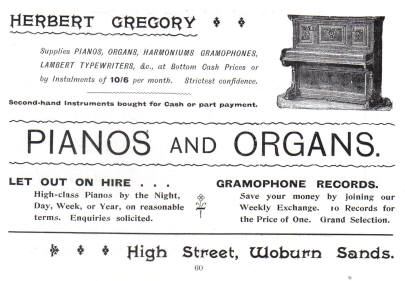
WESLEYAN CHAPEL – This is a compact little building, having inscribed on its front, “Methodist Chapel, 1813.” A gallery – usually occupied by the children on Sundays – extends about a quarter of the length of the building from the entrance, The Chapel is about 10 minutes’ walk East from the centre of the Village, and is situated at the foot of Mount Pleasant. The Services here are usually taken by local preachers, or the Super-intendent or Assistant Minister of the district. On Sundays the Services commence at 2.30p.m. and 6p.m. There is also a Wesleyan Sunday School held in the Chapel, commencing at 10a.m. The children are again admitted at 2p.m. The Superintendent is Mr. Thomas Busby, well known for his many years of honest and useful work. A few interments years ago took place in the ground in front of the Chapel, but no mounds indicate this, nor does any tablet record the names of those who sleep beneath.
MISSION HALL – The Mission Hall, formerly called the Mission Room, was erected in 1842. It was first used as a “British School,” during weekdays, but was finally merged into the Board School, Woburn Lane, which in turn has now passed under the control of the County Council. The building is a well-arranged and commodious one, situated near the centre of the Village. Services here, for very many years past, have been conducted by Miss Courtney and Miss Laws, two ladies known far and wide for their good and noble lives, and their excellent work in this and the Total Abstinence cause. Services commence on Sundays at 11.15a.m., and 6p.m.
Parish Hall etc Aspley can also boast of a large Parish Hall, built in 1901 at a cost of about £1,800, £800 of which was given by His Grace the Duke of Bedford, K.G.; while the late Alderman E. E. Dymond, J.P., and the late H. P. Harris, Esq., J.P., also contributed handsomely, besides jointly giving the ground on which the Hall is erected. The Hall contains Reading-room, Parish Council chamber, &c.; and was kindly opened by Her Grace the Duchess of Bedford, in 1902.
The Reading-room, previously, had for many years mainly depended on the generosity of Dr. H. Veasey. There is a good Day-school in the Village, and an extensive Printing Works – The Powage Press, Ltd. – one of the largest in the county, and from which emanates the worldwide known “Kemp’s Mercantile Gazette,” and many other publications. The premises occupied by The Powage Press are those formerly used by the old Classical School, whose bell, dated 1783, no longer summons scholars to tasks, or dismisses them to their play, but remains here, stowed away under the “cases” in the Printing Works, a silent witness to the changes of this ever-changing world.
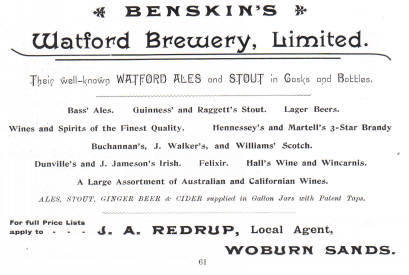
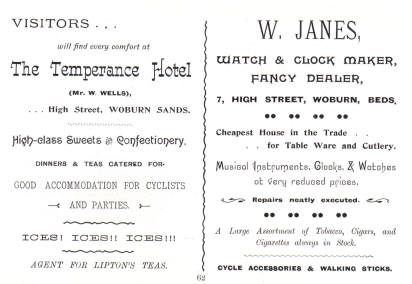
Old bell, thy voice is silent now,
Nor could’st thou reach them all,
If thou rang out as ne’er before
Thy loud imperious call.
For some have gone to distant lands,
But most sleep ‘neath the sod
Till other sound shall call them forth
To join the hosts of GOD.
Cricket Ground
There is a well-laid-out Cricket Ground, most pleasantly situated on the Common, and provided gratis for the benefit of the Club by William. Mahon, Esq. The beauty of the scenery from this delightful spot cannot fail to impress the onlookers even should they suffer from ennui in watching the play. Practice is allowed on all week-days, as a rule, excepting Saturday, which is usually reserved for matches.
Wild Flowers
Permission to gather wild flowers in the Duke of Bedford’s Woodlands has again kindly been granted by His Grace to ticket holders – the tickets are obtained on application to the Park Farm Office. It is to be hoped that no ruthless or wanton destruction of hedges, young trees, etc., will be done by anyone, to cause an abrogation of the privilege. To be able to roam in haunts of beauty and gather the wild flowers – GOD’S messages of love to us – are things to be appreciated, and due regard for the preservation of the Woodlands from mutilation in any form, will certainly be exercised by all who truly delight in Nature’s charms and beauty.
Woburn
The town of Woburn, 42 miles from London, 13 miles from Bedford, and nearly 3 miles from Woburn Sands Station, is very pleasantly situated, and sufficiently elevated to command a fine and healthy air. It stands on the great highway to Manchester and the North of England, and at a point about two miles distant, the old Roman road, known as Watling Street, is reached. From whatever point it is approached, the visitor to the town cannot fail to be impressed with its favourable position, and its neat and spacious thoroughfares. The main street is broad, and lined with modern business and residential premises, and the immediate neighbourhood presents a rare and exquisite diversity of charming landscapes. The population at the last census was 1,129. The town is of great historical antiquity, Doomsday Book recording its status and the holding of its lands and appurtenances by Walter Gifard and Hugh de Bolbec, the father of the Baron who laid the first foundation of Woburn Abbey. In 1595, Woburn suffered severe loss by fire, and again early in the 18th century a considerable number of houses were destroyed by the same agency, the present town having been built chiefly since that period. The town has been favoured by Royalty as far back as 1572, when Queen Elizabeth visited Woburn and the Abbey; and in 1644 and the following year, King Charles the First was the guest of the Earl of Russell. In connection with this last visit, old records state that in November a body of Royalist horse had a sharp engagement with the townsfolk, the opportunity being seized by a gang of desperate fellows of the neighbourhood to plunder and set fire to the houses at the Newport end of the town, the tower of the old church being also involved in the conflagration. The ill-fated monarch passed through the town a third time (in 1647)1 when the proposals of the army were submitted to him at the house of Earl Russell (Woburn Abbey). Coming down to later days, Queen Victoria and the Prince Consort visited the Abbey in the summer of 1841, under circumstances attended with great jubilation on the part of a loyal public.
The Old Church
The Church of St. Mary the Virgin, in Bedford-street, now used as a Mortuary Chapel, was, according to ancient writings, styled Woburn Chapel, and annexed to a Church at Birchmore, being given to the Abbot and convent in 1242. It underwent thorough repair in 1800-1, at which time the tower stood about 6 yards distant from the north aisle, to which it was formerly united by an apartment occupied by the parish clerk. From the fact that the arms and ciphers of Abbot Hobbs appeared on the pilasters and in the Church, he is supposed to have rebuilt the whole fabric. In 1830, the tower, which had become unsafe, was rebuilt by John, the fourth Duke of Bedford, and the two succeeding Dukes also carried out considerable improvements to the building. In 1865, however, the time of William, the eighth Duke, the Church, with the exception of the tower, was pulled down, and the materials used in the erection of the present Mortuary Chapel, which contains many of the mural tablets, coats-of-arms, and brasses which formerly found a place in the original Church. The present tower, which is strikingly handsome and picturesque, contains a fine peal of 8 bells, 6 of which were purchased by subscriptions, assisted by John, the sixth Duke of Bedford, who also presented the clock. Duke Hastings added two other bells, the completed peal being opened in 1877. Surrounding the Chapel is a well-laid-out cemetery, flanked on one side of the entrance by the Infant School (in close proximity to which is the Fire-engine House) and on the other side by the Old Parsonage – the latter is now fitted up with gymnasium apparatus for the lads of the town. The churchyard is screened from Bedford-street by a lofty iron railing and gates, with handsome panelled stone piers.
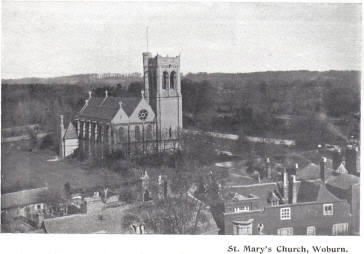
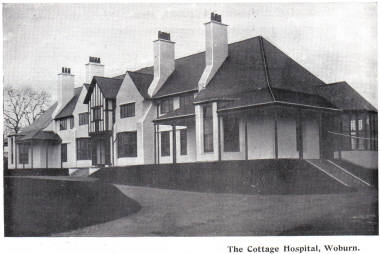
The New Church.
This Church, situate in Park Street, is a handsome edifice constructed of Bath stone, and was erected during the years 1865-8 at the expense of William, the eighth Duke of Bedford, costing the sum of £35,000. The interior is splendidly proportioned. Three of the four stained windows were given by Duchess Adeline, in 1894, in memory of her husband; the present Duke has embellished the chancel with splendidly carved choir stalls, pulpit, and organ gallery, and also a richly gilded and coloured reredos, 26 feet high and 12 feet wide; and on Easter Sunday, 1904, a magnificent new organ was formally opened, this being also given by His Grace. The Church formerly possessed a lofty spire, but owing to fears of its safety, it was, a few years ago, taken down and converted into the present castellated tower, which contains the largest bell in the county, weighing 55 cwts. The bell, however, is but rarely used. The living is in the patronage of the Duke of Bedford, the Vicar being the Rev. C. R. Dickinson, M.A.
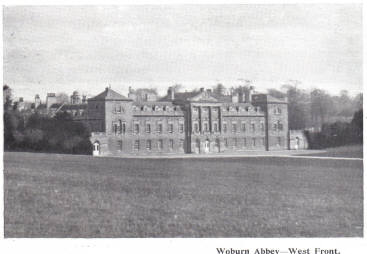
The Town Hall.
The Town Hall stands in the centre of the town. The original building, erected by John, the fourth Duke of Bedford, in 1737, was used as a market house, but owing to its bad state of repair, was pulled down in 1830. It was of a stately character, three storeys in height, and surmounted by a handsome gilt vane. The present building is in the Gothic style, the side arches, which formerly contained open ironwork, now being filled with windows. In 1884, the hall was altered and renovated by Hastings, the ninth Duke of Bedford, and now consists of a fine and well-proportioned room, which is used for Petty Sessions, public meetings, etc. Its ceiling is of stained pine, the floor of wooden blocks, and it contains a massive and elegant fire-place. There is also a small room upstairs. Around and about the Hall are placed iron posts, which also flank the main road for some distance – an unusual feature.
Miscellaneous
Among other buildings of interest are the ALMSHOUSES, 20 in number, standing at the North end of Bedford Street. They originated in a bequest by the will of Sir Francis Staunton, 1635. Other estates were bequeathed in 1665, and in 1672 these combined charities were granted to John, Duke of Bedford, on condition that he founded an almshouse and endowed it with £30 yearly.
SCHOOLS.-The building which now serves for the infants is a substantial ivy-covered edifice of the Elizabethan era, corresponding with the adjacent engine-house; the original Free School being founded by Francis, Earl of Bedford. In 1825 the Girls’ School adjoining was established, and in 1845 the Duke of Bedford built the Boys’ School in Leighton Street.
In Chapel Street a covered passage leads to the CONGREGATIONAL CHURCH, which was founded in 1789, the present building dating from 1804. It was enlarged and repaired in 1823 and 1854. In 1897 the vestry was enlarged to twice its original size, and subsequently a scheme of renovation has been carried out at a cost of £260, the building now presenting a very pleasing interior. Michael Castleden preached here for 40 years, and the late Rev. James Andrews occupied the pulpit for 52 years. The Rev. J. I. Davies, A.T.C., is the present Pastor. In Leighton Street stands the WESLEYAN CHAPEL, which has also been renovated in modern style, and is served by circuit ministers and local preachers.
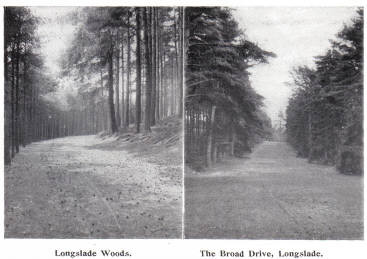
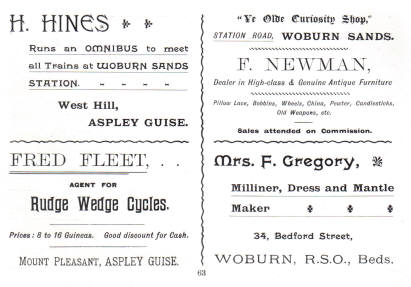
In Leighton Street are also situated the INSTITUTE and READING ROOMS, which were erected in 1884 by Hastings, the 9th Duke, at which time the volumes and other properties of the Institute were removed from the Town Hall to the present rooms, which also contain a billiard table. Higher up the same street several blocks of cottages and villa residences have been erected by the Duke of Bedford in place of old properties which have been removed by His Grace.
The Cottage Hospital
The Cottage Hospital stands a little further on. It was erected by the Duchess of Bedford, in 1902-3, and is replete with every possible convenience, and fitted up with the latest requirements that modern medical science can possibly devise. It will accommodate 12 persons, with necessary attendants, and has already proved a great boon to the neighbourhood. Her Grace personally takes a keen interest in the Hospital. A local writer has eulogised it in verses, two of which run thus:-
Behold on Woburn’s western heights,
A noble edifice now raised;
No stately mansion of voluptuous ease
Where nought but luxury is praised:
But reared in Charity’s sweet cause,
To bring some sunshine in life’s frequent rain,
To raise the weary, fallen by the way,
And ease the weight of human pain.
Along the Bedford road, at a short distance from the Vicarage, is the approach to a well-appointed LAWN TENNIS and CROQUET GROUND for the use of members of the South Beds. Club, and the Town Club has also a ground at the rear of the Bedford Arms Hotel, There are several Lodges of Benefit Societies and philanthropic institutions in the town; it is also the centre of a Horticultural and Floral Society, which for over 40 years has held an Annual Show on August Bank Holiday. The Postal arrangements are thoroughly efficient, and there is a good Omnibus Service between the Bedford Arms Hotel and Woburn Sands Station.
Woburn Abbey.
The Abbey stands on the site of a monastery founded in 1145 by Hugh de Bolbec, the son of a Norman baron, who came over with the Conqueror. It was an abbey of Cistercian monks. In 1234 the establishment was broken up through poverty, and the monks were dispersed into various convents. Various abbots had charge of the place until about 1521, when Robert Hobbs, the last and most famous of the order, ruled the monastery. He it was who denied the Supremacy of King Henry VIII at the time when the King’s Commissioners were making a visitation of the monasteries with a view to their dissolution. Indignant at the unfounded charges brought against him, the Abbot surrendered his monastery, threw off his allegiance to the monarch, and cast in his lot with the insurgents, probably in Lincolnshire or Yorkshire. He was taken in arms, brought back a prisoner to the scene of his former rule, and hanged on an oak in view of his monastery. The tree still stands, and bears an inscribed tablet recording a dissertation by Wiffen on the event.
In 1547 the site and possessions of the Abbey were granted to Lord John Russell, of Chenies, who in 1550 was created the first Earl of Bedford, and from 1570 Woburn Abbey has been the principal seat of the house of Russell. The building itself is said to have been repaired and modernised by Inigo Jones about 1620, and the Conventual Church was supposed to have been situated near the cloisters at the East front, which were left standing till 1700. About that time, under Francis, the fifth Duke, the rebuilding of the great quadrangle in the Roman style in which it now appears, was commenced by Flitcroft. The cloisters were demolished, and a suite of rooms erected in their place. Duke Francis also built the Stables, the Riding School, Tennis Court, the building now known as the Sculpture Gallery, and the Terrace on the South side. John, the sixth Duke, while on a long stay in Italy, in 1817-8, formed the magnificent collection of sculpture now in the Gallery. Various additions to the building have since been made by successive Dukes, The present Abbey may fitly be styled a treasure house of art, with its portraits, paintings, and engravings by the greatest masters; bronzes, casts, and the superb collection of marbles in the Sculpture Gallery. The State apartments are magnificently furnished and decorated, and contain many priceless art treasures.
The surrounding pleasure grounds and gardens are tastefully laid out, and present a charming aspect of sward, foliage, and lakes. There is a pretty and fairy-like Chinese Dairy, Grottoes, Plant-houses, etc., and a Labyrinth; and a covered way leads to the Tennis Court and Riding School, which has been recently renovated and improved. A new building has also been constructed for the purposes of a Museum. A short distance to the North-West of the Abbey are the spacious and well-appointed Kitchen Gardens. Constant attention is given to the maintenance and preservation of the Abbey and its precincts by the present Duke and Duchess of Bedford, who are justly proud of their ancestral domain, to the beauty and value of which they themselves have contributed in no small degree. The Sculpture Gallery and Pleasure Grounds have been open to the public on August Bank Holiday for many years by the kindness of His Grace, on the occasion of the local Flower Show. The Abbey is only open to visitors by special permission.
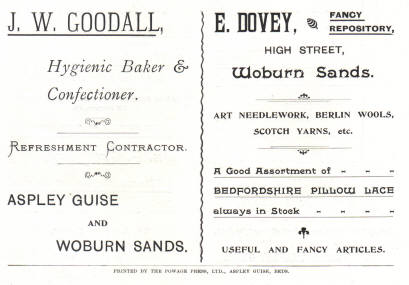
Woburn Park.
This is one of the largest in England, containing nearly 3,000 acres. The chief entrance is on the London side of the town, and consists of a handsome portal and ornamental gates, with a facade decorated with Ionic columns, its approach being screened from the highway by chains and piers. It was built in 1810 by John, sixth Duke of Bedford. The drive from the entrance to the Abbey passes the picturesque PARIS HOUSE, which is now used as a Shooting Lodge. The other entrance to the Park from the town, is just below the Church, in Park Street, the gates being supported by substantial columns, surmounted by finely carved stone figures of lions, couchant. The roadway passes between two lakes, in the largest of which there is an island, on which a typical Chinese temple is built. On either side of the road are plantations of the famous evergreens, backed by tall cedars, firs, and pines, which provide many charming walks. On arrival at the second gates the open park is entered. It will be seen to comprise a pleasant variety of hill and dale, studded with noble oaks and elms. The road straight ahead leads to Eversholt, and is a public road; those to the right and left are private. The view on the right discloses the estate offices and buildings, and the elegant new dairy, recently erected, opposite which still stand the buildings and clock as depicted in the well-known engraving entitled “Woburn Sheep Shearing.” On the left hand is the Cricket Ground, maintained for the Town Club by the Duke of Bedford; this has been the scene of many encounters in the old days, when the avenue of beeches sheltered many notable spectators. Hereabouts may be seen numerous varieties of deer, and roaming at will over the spacious sward may often be observed llamas, yaks, zebras, Indian cattle, and wild horses. In the enclosures near the head-keeper’s house, are camels, goats, and some of the rarer species of deer, while near the New Farm, a mile or so distant, are domiciled magnificent specimens of buffaloes, gnus, and recent additions of giraffes. These enclosures and paddocks, however, are private, and strangers can only visit them under special circumstances. The splendid lakes in the park are the habitation of countless wild fowl, ranging from the stately heron to the common wild duck. In addition to the ordinary swans, there are some fine specimens with black necks, and some black entirely. Here and there a flight of storks may be seen disporting themselves, and emus and rheas are nearly always stalking around. Fresh specimens of animals and birds are frequently added by their Graces, who take the keenest interest in their unique collection.
If you have any different guide books to the local area, I would be pleased to hear about them.
Webpage last updated Nov. 2018
